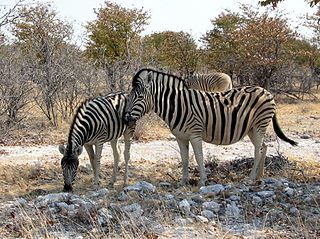 W
WThis is a list of the mammal species recorded in Botswana. There are 170 mammal species in Botswana, of which one is critically endangered, one is endangered, six are vulnerable, and six are near threatened.
 W
WThe African striped weasel, the lone member of its genus, is a small, black and white weasel native to sub-Saharan Africa.
 W
WThe African wildcat is a small wildcat species native to Africa, West and Central Asia up to Rajasthan in India and Xinjiang in China. The IUCN Red List status Least Concern is attributed to the species Felis silvestris, which at the time of assessment also included the African wildcat as a subspecies.
 W
WThe sable antelope is an antelope which inhabits wooded savanna in East and Southern Africa, from the south of Kenya to South Africa, with a separate population in Angola.
 W
WThe chacma baboon, also known as the Cape baboon, is, like all other baboons, from the Old World monkey family. It is one of the largest of all monkeys. Located primarily in southern Africa, the chacma baboon has a wide variety of social behaviors, including a dominance hierarchy, collective foraging, adoption of young by females, and friendship pairings. These behaviors form parts of a complex evolutionary ecology. In general, the species is not threatened, but human population pressure has increased contact between humans and baboons. Hunting, trapping, and accidents kill or remove many baboons from the wild, thereby reducing baboon numbers and disrupting their social structure.
 W
WThe black-tailed tree rat, also called black-tailed acacia rat or black-tailed thallomys,, is a species of rodent in the family Muridae. It is found in Angola, Botswana, Namibia and South Africa, where its natural habitat is subtropical or tropical dry shrubland. It is both nocturnal and arboreal and makes bulky nests in the trees, often acacias, where it feeds on leaves and buds.
 W
WBrants's whistling rat or Brants' whistling rat is one of two species of murid rodent in the genus Parotomys. It is found in Botswana, Namibia, and South Africa where its natural habitats are subtropical or tropical dry shrubland and pastureland. It was first described in 1834 by the Scottish zoologist Andrew Smith who named it in honour of the Dutch zoologist and author Anton Brants.
 W
WBurchell's zebra is a southern subspecies of the plains zebra. It is named after the British explorer and naturalist William John Burchell. Common names include the bontequagga, Damaraland zebra, and Zululand zebra. Burchell's zebra is the only subspecies of zebra which may be legally farmed for human consumption.
 W
WThe Mohol bushbaby is a species of primate in the family Galagidae which is native to mesic woodlands of the southern Afrotropics. It is physically very similar to the Senegal bushbaby, and was formerly considered to be its southern race. The two species differ markedly in their biology however, and no hybrids have been recorded in captivity.
 W
WThe Bushveld horseshoe bat is a species of bat in the family Rhinolophidae.
 W
WThe Cape wild dog, also known as the South African wild dog, Cape hunting dog, or the painted wolf, is the nominate subspecies of African wild dog native to Southern Africa.
 W
WThe black-footed cat, also called the small-spotted cat, is the smallest wild cat in Africa, having a head-and-body length of 35–52 cm (14–20 in). Despite its name, only the soles of its feet are black or dark brown. With its bold small spots and stripes on the tawny fur, it is well camouflaged, especially on moonlit nights. It bears black streaks running from the corners of the eyes along the cheeks, and its banded tail has a black tip.
 W
WChapman's zebra, named after its discoverer James Chapman, is a closely related subspecies of the plains zebra.
 W
WThe Southeast African cheetah is the nominate cheetah subspecies native to East and Southern Africa. The Southern African cheetah lives mainly in the lowland areas and deserts of the Kalahari, the savannahs of Okavango Delta, and the grasslands of the Transvaal region in South Africa. In Namibia, cheetahs are mostly found in farmlands.
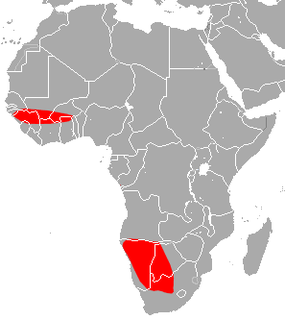 W
WDent's horseshoe bat is a species of bat in the family Rhinolophidae. It is found in Angola, Botswana, Ghana, Guinea, Guinea-Bissau, Namibia, South Africa, and Zimbabwe. The bat's natural habitats are dry savannah country and it roosts in caves and other subterranean habitats.
 W
WThe common eland, also known as the southern eland or eland antelope, is a savannah and plains antelope found in East and Southern Africa. It is a species of the family Bovidae and genus Taurotragus. An adult male is around 1.6 metres (5') tall at the shoulder and can weigh up to 942 kg (2,077 lb) with an average of 500–600 kg (1,100–1,300 lb), 340–445 kg (750–981 lb) for females). It is the second largest antelope in the world, being slightly smaller on average than the giant eland. It was scientifically described by Peter Simon Pallas in 1766.
 W
WThe bat-eared fox is a species of fox found on the African savanna. It is the only extant species of the genus Otocyon and considered a basal canid species. Fossil records show this canid to first appear during the middle Pleistocene.
 W
WThe Cape fox, also called the asse, cama fox or the silver-backed fox, is a small fox, native to southern Africa. It is also called a South African version of a fennec fox due to their big ears. It is the only true fox occurring in sub-Saharan Africa, and it retains primitive characteristics of Vulpes because it diverged early in the evolutionary history of the group.
 W
WThe gemsbok, gemsbuck or South African oryx is a large antelope in the genus Oryx. It is native to the arid regions of Southern Africa, such as the Kalahari Desert. Some authorities formerly included the East African oryx as a subspecies.
 W
WThe Angolan giraffe, also known as the Namibian giraffe, is a subspecies of giraffe that is found in northern Namibia, south-western Zambia, Botswana, and western Zimbabwe.
 W
WThe red hartebeest is a species of even-toed ungulate in the family Bovidae found in Southern Africa. More than 130,000 individuals live in the wild. The red hartebeest is closely related to the tsessebe and the topi.
 W
WThe klipspringer is a small antelope found in eastern and southern Africa. The sole member of its genus, the klipspringer was first described by German zoologist Eberhard August Wilhelm von Zimmermann in 1783. The klipspringer is a small, sturdy antelope; it reaches 43–60 centimetres at the shoulder and weighs from 8 to 18 kilograms. The coat of the klipspringer, yellowish gray to reddish brown, acts as an efficient camouflage in its rocky habitat. Unlike most other antelopes, the klipspringer has a thick and coarse coat with hollow, brittle hairs. The horns, short and spiky, typically measure 7.5–9 cm.
 W
WThe greater kudu is a woodland antelope found throughout eastern and southern Africa. Despite occupying such widespread territory, they are sparsely populated in most areas due to declining habitat, deforestation, and poaching. The greater kudu is one of two species commonly known as kudu, the other being the lesser kudu, T. imberbis.
 W
WThe common dwarf mongoose is a mongoose species native to Angola, northern Namibia, KwaZulu-Natal in South Africa, Zambia and East Africa. It is part of the genus Helogale and as such related to Helogale hirtula.
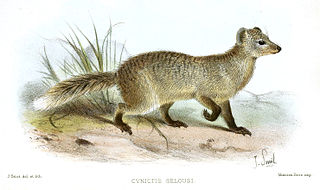 W
WSelous's mongoose is a mongoose species native to Southern Africa. It is the only member of the genus Paracynictis.
 W
WThe vervet monkey, or simply vervet, is an Old World monkey of the family Cercopithecidae native to Africa. The term "vervet" is also used to refer to all the members of the genus Chlorocebus. The five distinct subspecies can be found mostly throughout Southern Africa, as well as some of the eastern countries. Vervets were introduced to Florida, St. Kitts and Nevis, and Cape Verde. These mostly herbivorous monkeys have black faces and grey body hair color, ranging in body length from about 40 cm (16 in) for females, to about 50 cm (20 in) for males.
 W
WThe ground pangolin, also known as Temminck's pangolin, Cape pangolin or steppe pangolin, is one of four species of pangolins which can be found in Africa, and the only one in southern and eastern Africa. The animal was named for the Dutch zoologist Coenraad Jacob Temminck. As a group, pangolins are among the most critically endangered animals in the world.
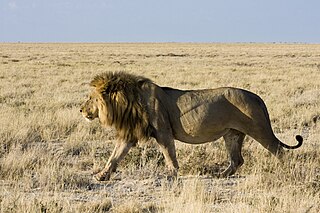 W
WPanthera leo melanochaita is a lion subspecies in Southern and East Africa. In this part of Africa, lion populations are regionally extinct in Lesotho, Djibouti and Eritrea, and threatened by loss of habitat and prey base, killing by local people in retaliation for loss of livestock, and in several countries also by trophy hunting. Since the turn of the 21st century, lion populations in intensively managed protected areas in Botswana, Namibia, South Africa and Zimbabwe have increased, but declined in East African range countries. In 2005, a Lion Conservation Strategy was developed for East and Southern Africa.
 W
WPercival's trident bat is a species of bat in the family Hipposideridae. It is monotypic within the genus Cloeotis. It is found in Botswana, Democratic Republic of the Congo, Kenya, Mozambique, South Africa, Swaziland, Tanzania, Zambia, and Zimbabwe. Its natural habitats are subtropical or tropical dry forests, dry savanna, and caves.
 W
WThe serval is a wild cat native to Africa. It is rare in North Africa and the Sahel, but widespread in sub-Saharan countries except rainforest regions. On the IUCN Red List it is listed as Least Concern. Across its range, it occurs in protected areas, and hunting it is either prohibited or regulated in range countries.
 W
WSharpe's or northern grysbok is a small, shy, solitary antelope that is found from tropical to south-eastern Africa.
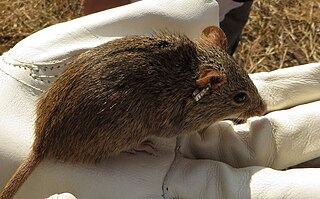 W
WThe single-striped grass mouse or single-striped lemniscomys is a species of rodent in the family Muridae.
 W
WThe sitatunga or marshbuck is a swamp-dwelling antelope found throughout central Africa, centering on the Democratic Republic of the Congo, the Republic of the Congo, Cameroon, parts of Southern Sudan, Equatorial Guinea, Burundi, Ghana, Botswana, Rwanda, Zambia, Gabon, the Central African Republic, Tanzania, Uganda and Kenya. The sitatunga is confined to swampy and marshy habitats. Here they occur in tall and dense vegetation as well as seasonal swamps, marshy clearings in forests, riparian thickets and mangrove swamps.
 W
WThe South African giraffe or Cape giraffe is a subspecies of giraffe ranging from South Africa, Namibia, Botswana, Zimbabwe, Mozambique. It has rounded or blotched spots, some with star-like extensions on a light tan background, running down to the hooves.
 W
WThe south-central black rhinoceros or south-central hook-lipped rhinoceros is a subspecies of the black rhinoceros. In line with the rules of zoological nomenclature, the South-central black rhinoceros should be known as Diceros bicornis keitloa, a nomen novum. Although it was the most numerous of the black rhino subspecies it is still listed as critically endangered by the IUCN red list. Like other black rhino subspecies it has a prehensile lip and lives in savanna habitat.
 W
WThe Southern African wildcat is an African wildcat subspecies native to Southern and Eastern Africa. In 2007, it was tentatively recognised as a distinct subspecies on the basis of genetic analysis. Morphological evidence indicates that the split between the African wildcat subspecies in Africa occurred in the area of Tanzania and Mozambique.
 W
WThe southern white rhinoceros or southern square-lipped rhinoceros, is one of the two subspecies of the white rhinoceros. It is the most common and widespread subspecies of rhinoceros.
 W
WThe Cape ground squirrel or South African ground squirrel is found in most of the drier parts of southern Africa from South Africa, through to Botswana, and into Namibia, including Etosha National Park.
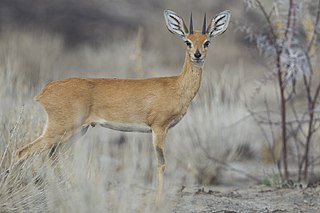 W
WThe steenbok is a common small antelope of southern and eastern Africa. It is sometimes known as the steinbuck or steinbok.
 W
WThe blue wildebeest, also called the common wildebeest, white-bearded wildebeest, or brindled gnu, is a large antelope and one of the two species of wildebeest. It is placed in the genus Connochaetes and family Bovidae, and has a close taxonomic relationship with the black wildebeest. The blue wildebeest is known to have five subspecies. This broad-shouldered antelope has a muscular, front-heavy appearance, with a distinctive, robust muzzle. Young blue wildebeest are born tawny brown, and begin to take on their adult coloration at the age of 2 months. The adults' hues range from a deep slate or bluish-gray to light gray or even grayish-brown. Both sexes possess a pair of large curved horns.